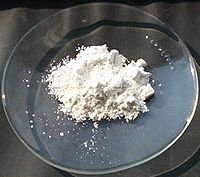
Back Antimoon(III)oksied Afrikaans أكسيد الأنتيموان الثلاثي Arabic سنارمونتیت AZB Òxid d'antimoni(III) Catalan Oxid antimonitý Czech Antimon(III)-oxid German Τριοξείδιο του αντιμονίου Greek Óxido de antimonio(III) Spanish سنارمونتیت Persian Antimonitrioksidi Finnish

| |
| Names | |
|---|---|
| IUPAC name
Antimony(III) oxide
| |
| Other names | |
| Identifiers | |
3D model (JSmol)
|
|
| ChemSpider | |
| ECHA InfoCard | 100.013.796 |
| EC Number |
|
| KEGG | |
PubChem CID
|
|
| RTECS number |
|
| UNII | |
CompTox Dashboard (EPA)
|
|
| |
| |
| Properties | |
| Sb2O3 | |
| Molar mass | 291.518 g/mol |
| Appearance | white solid |
| Odor | odorless |
| Density | 5.2 g/cm3, α-form 5.67 g/cm3 β-form |
| Melting point | 656 °C (1,213 °F; 929 K) |
| Boiling point | 1,425 °C (2,597 °F; 1,698 K) (sublimes) |
| 370±37 μg/L between 20.8 °C and 22.9 °C | |
| Solubility | soluble in acid |
| −69.4×10−6 cm3/mol | |
Refractive index (nD)
|
2.087, α-form 2.35, β-form |
| Structure | |
| cubic (α) < 570 °C orthorhombic (β) > 570 °C | |
| pyramidal | |
| zero | |
| Hazards | |
| GHS labelling: | |
 [1] [1]
| |
| Warning[1] | |
| H351[1] | |
| P281[1] | |
| NFPA 704 (fire diamond) | |
| Lethal dose or concentration (LD, LC): | |
LD50 (median dose)
|
7000 mg/kg, oral (rat) |
| NIOSH (US health exposure limits): | |
PEL (Permissible)
|
TWA 0.5 mg/m3 (as Sb)[2] |
REL (Recommended)
|
TWA 0.5 mg/m3 (as Sb)[2] |
| Related compounds | |
Other anions
|
Antimony trisulfide Antimony triselenide Antimony telluride |
Other cations
|
Dinitrogen trioxide Phosphorus trioxide Arsenic trioxide Bismuth trioxide |
Related compounds
|
Diantimony tetraoxide Antimony pentoxide |
| Supplementary data page | |
| Antimony trioxide (data page) | |
Except where otherwise noted, data are given for materials in their standard state (at 25 °C [77 °F], 100 kPa).
| |
Antimony(III) oxide is the inorganic compound with the formula Sb2O3. It is the most important commercial compound of antimony. It is found in nature as the minerals valentinite and senarmontite.[3] Like most polymeric oxides, Sb2O3 dissolves in aqueous solutions with hydrolysis. A mixed arsenic-antimony oxide occurs in nature as the very rare mineral stibioclaudetite.[4][5]
- ^ a b c d Record of Antimony trioxide in the GESTIS Substance Database of the Institute for Occupational Safety and Health, accessed on 23 August 2017.
- ^ a b NIOSH Pocket Guide to Chemical Hazards. "#0036". National Institute for Occupational Safety and Health (NIOSH).
- ^ Greenwood, N. N.; & Earnshaw, A. (1997). Chemistry of the Elements (2nd Edn.), Oxford:Butterworth-Heinemann. ISBN 0-7506-3365-4.
- ^ "Stibioclaudetite".
- ^ "List of Minerals". 21 March 2011.
